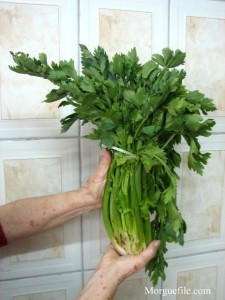If you’re up for a challenge, try growing celery (Apium graveolens dulce). It’s worth the effort. Home grown celery has a stronger, full flavor and each crunch is loaded with juiciness. Although not the easiest of vegetable to grow at home, you just need a long (up to four months) growing season, cool temperatures, and moist soil. That sounds like a lot of places in the Northeast to me.
Beside eating celery raw in salads and for dips, it’s great in soups, stews, and sauces. Since it’s mostly water and fiber, it’s low in calories, too.
When to Plant
Plant celery seeds indoors three months before your last spring frost. Transplant purchased seedlings or home grown ones into the garden
around your last frost date in May. Ideal temperatures for celery growing are between 55F and 70F. If celery transplants experience temperatures below 55F for more than one week, they may bolt (produce a flower stalk). Protect young transplants by placing a floating row cover over plants during cool spring nights.
Where to Plant
Celery needs full sun and well-drained fertile soil to grow to maturity. Plant it in the garden where these 2-foot tall plants won’t be shaded by other taller vegetables as the summer winds on.
How to Plant
Soak seeds overnight in warm water to hasten germination. Amend the soil well with compost before planting. Plant individual seedlings 1 foot apart in rows spaced 18 inches apart.
Care and Maintenance
Celery need regular feeding and watering to grow its best. Add a small handful of granular organic fertilizer, such as 5-5-5 monthly, around plants to stimulate growth. Keep plants well watered. If the soil driers out , the celery stalks will turn tough and stringy. Add a organic mulch, such as straw or untreated grass clippings, around established plants to keep the soil moist and weeds at bay.
Prevent slugs from feasting on young transplants with organic slug baits such as Sluggo, beer traps placed around beds, or diatomaceous Earth, sharp sand or crushed oyster shells sprinkled around plants. Watch for aphids on leaves and spray with insecticidal soap to control them.
Harvest
Harvest celery plants when the stalks are 10 inches tall. Cut the entire plant at the base with a sharp knife. If you’re not growing self-blanching varieties and want a milder tasting and more tender celery stalk, mound up the soil 6 inches high around plants to blanch them (block the light) a few weeks before harvest.
Additional Information
There are only a few varieties commonly grown by home gardeners. ‘Tango Hybrid’ matures in only 85 days and produces non-stringy stalks and is self blanching. ‘Tall Utah’ is an old fashioned variety still popular. ‘Giant Red’ has unique red-tinged stalks.
An easier to grow alternative to traditional celery is cutting celery (Apium graveolens). These plants are grown the same way as stalk celery, but they form 18 inch tall plants with only leaves containing a rich celery flavor.
Text excepted from the Northeast Vegetable and Fruit Gardening book.



